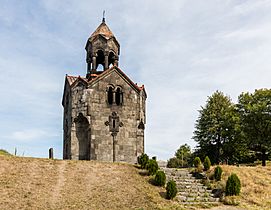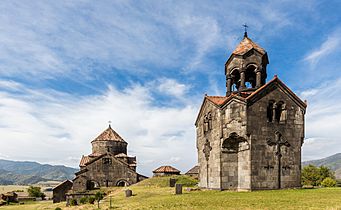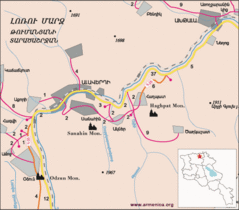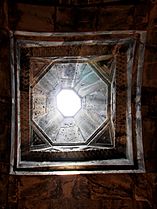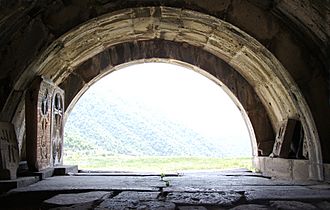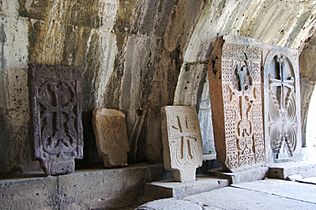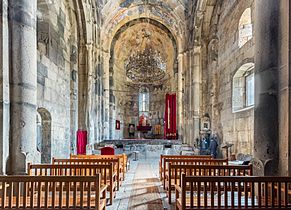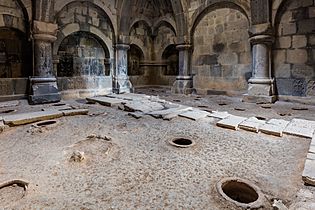Haghpat Monastery facts for kids
Quick facts for kids Haghpat MonasteryՀաղպատավանք |
|
|---|---|
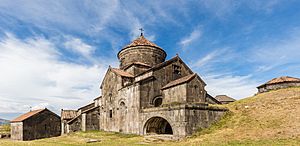
The Church of Surp Nshan at Haghpat Monastery
|
|
| Religion | |
| Affiliation | Armenian Apostolic Church |
| Location | |
| Location | Haghpat, Lori Province, Armenia |
| Architecture | |
| Architectural style | Armenian |
| Groundbreaking | 10th century |
| Official name: Monasteries of Haghpat and Sanahin | |
| Type | Cultural |
| Criteria | ii, iv |
| Designated | 1996 (20th session) |
| Reference no. | 777 |
| UNESCO Region | Europe and North America |
Haghpat Monastery, also known as Haghpatavank (Armenian: Հաղպատավանք), is an ancient monastery complex located in Haghpat, Armenia. It's a very old and important place where monks used to live and study many centuries ago.
Contents
What is Haghpat Monastery?
The monastery was likely started by Queen Khosrovanuysh in the year 976. She was the wife of King Ashot III, a ruler from the Bagratid family. Another monastery, called Sanahin, was built nearby around the same time.
The Main Church
The biggest church at Haghpat is called the Cathedral of Surb Nishan. Its construction probably began in 976 and was finished in 991 by King Smbat. This church is a great example of Armenian architecture from the 10th century.
Its main dome (a rounded roof) sits on four large pillars that are part of the side walls. Inside, you can see a picture of Prince Khutulukhaga in the south transept. A transept is like a side arm of the church that crosses the main part. There's also a bas-relief (a sculpture that sticks out from a flat surface) showing Queen Khosravanuysh with her sons, Princes Smbat and Kurike. The church has been kept in its original form, with only a few small repairs done in the 11th and 12th centuries.
Other Buildings
Haghpat Monastery has several other interesting buildings:
- The small, domed Church of Sourb Grigor (St. Gregory) was built in 1005.
- Two side chapels (smaller churches) were added later. The bigger one was built in the early 13th century. The smaller one, known as "Hamazasp House," was built in 1257.
- Other additions from the 13th century include the chapel of Sourb Astvatsatsin, a scriptorium, and a large refectory. A scriptorium was a room where monks copied books by hand. A refectory was a dining hall.
Cross-Stones
You can also find many beautiful khachkars (cross-stones) around the monastery. These are carved stones with crosses and other designs, made between the 11th and 13th centuries.
Damage and Restoration
Haghpat Monastery has faced challenges over the years. Around 1130, an earthquake damaged parts of it, and it took about 50 years to repair. It also survived many attacks by armies throughout its long history. Even a big earthquake in 1988 caused some damage. However, most of the monastery is still standing today, looking much like it did centuries ago.
Today, Haghpat Monastery is a popular place for tourists to visit and learn about history.
UNESCO World Heritage Site
Haghpat Monastery is considered a "masterpiece of religious architecture and a major center of learning in the Middle Ages" (a time period from about 500 to 1500 AD). Because of its importance, UNESCO (the United Nations Educational, Scientific and Cultural Organization) added Haghpat Monastery, along with Sanahin Monastery, to its World Heritage List in 1996.
UNESCO chose these monasteries because:
- They show the best of Armenian religious architecture.
- They have a special style that mixes ideas from Byzantine church building with traditional local building styles from the Caucasian region.
Gallery
-
The belltower at Haghpat Monastery
-
Haghpat, looking from inside out; note cross stones or khachkar's on left and right
-
Cross stones or khachkars at Haghpat Monastery, Armenia
See also
 In Spanish: Monasterio de Haghpat para niños
In Spanish: Monasterio de Haghpat para niños



